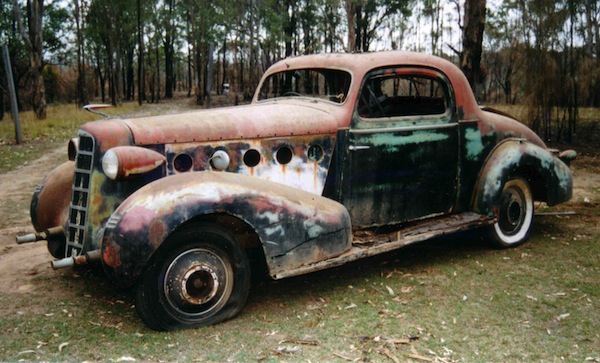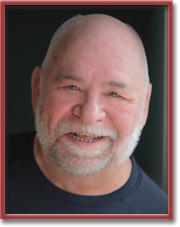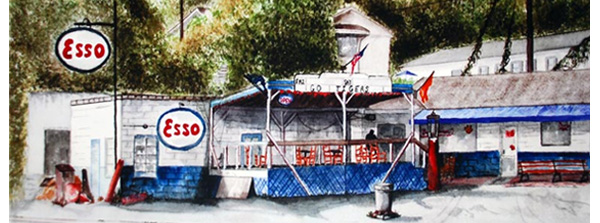The Cotton Bale & The 20s Chevy: A Story from My Father (Revisited)
“We started with an outhouse in the yard and a hand pump in the kitchen. The contractor installed indoor plumbing, but the house was still drafty and we had a single wood stove for heat. In the winter, there might be ice in the toilet bowl in the morning and the exposed copper pipes under the house were prone to burst.”—Ted Balk
Dispatches from The Esso Club
By Ted Balk

Author’s note: The following tale derives from many fondly remembered nights of sitting around the kitchen table at my parents’ home in Elko, SC. Frequently, the dramatis personae would have dwindled to just my father and me; my mother and siblings having gone to bed earlier. There would usually be a bottle of very good bourbon sitting between us, the level slowly dropping as Papa reminisced. This is one of the bits of family lore gleaned from these sessions. (This essay first appeared on “Weekly Hubris” in September 2013.)
 CENTRAL South Carolina—(Weekly Hubris)—June 2018—The car was distinctive in many ways. It wasn’t new, that’s for sure. It was a mid-1920s-model Chevy that had been just about completely stripped down. The old four-cylinder engine was running on only two cylinders. The vacuum fuel feed system wasn’t working, so you had to manually add gas as you drove along (more about that later). There was hardly enough sheet metal left on the body to say it had ever had a color but, if you had to guess, you would probably go for black under the rust. Just about its only attractive feature was the price.
CENTRAL South Carolina—(Weekly Hubris)—June 2018—The car was distinctive in many ways. It wasn’t new, that’s for sure. It was a mid-1920s-model Chevy that had been just about completely stripped down. The old four-cylinder engine was running on only two cylinders. The vacuum fuel feed system wasn’t working, so you had to manually add gas as you drove along (more about that later). There was hardly enough sheet metal left on the body to say it had ever had a color but, if you had to guess, you would probably go for black under the rust. Just about its only attractive feature was the price.
I got it for four dollars from an old handyman/laborer who thought he had already gotten all the good out of it working in downtown Augusta. I had turned 16 that February, hadn’t had my driver’s license long and this was just too good a deal to pass up.
My best friend Hal borrowed his mother’s car and dropped me off near Grady Carpenter’s store on Central Avenue to close the deal. He followed me to make sure the Chevy and I made it the three miles out to the farm, which was near the Boy Scout camp on Rae’s Creek. I figured we could use the Chevy as an all-purpose vehicle around the place, and that’s what we did.
Author’s Aside: Readers who are familiar with The Masters golf tournament held annually at the beautiful Augusta National Golf Club may have heard references to Rae’s Creek, which runs through the course. The farm in this story was located just a few miles from the site that was to become Augusta National, and bordered on famous Rae’s Creek.
Now, you need to understand the nature of our family’s new home. In the middle of the Depression, Dad bought 40 acres with an old farm house that he had a contractor fix up after we moved in.
We started with an outhouse in the yard and a hand pump in the kitchen. The contractor installed indoor plumbing, but the house was still drafty and we had a single wood stove for heat. In the winter, there might be ice in the toilet bowl in the morning and the exposed copper pipes under the floor were prone to burst.
Our family moved here from “The Hill” section of Augusta in 1936. The move wasn’t made entirely for economic reasons although, in those times, everyone was aware of the necessity for thrift, and we could grow most of our own food in the country.
Dad was Theodore Balk, Sr., called “Tee” by his friends, and was the manager of the only savings and loan business in Augusta at the time. Even during the Depression, the family was comfortable. But, in 1936, Mama and Dad had a family of four active boys and Mama thought a country setting might be a better environment for us.
We settled in well, planted a garden and strawberry beds, and hired local hands to plow the land and plant and harvest other crops. We also kept a milk cow, turkeys and chickens. Dad was really a city banker and didn’t have a clue about running a farm, but it was a nice place for us boys. We reluctantly tended the garden, milked the cow, gathered the eggs, caught, killed, and cleaned the poultry for meals, and picked and sold strawberries.
We would ride our bikes to school in town and then spend our spare time running wild through the country with neighbor kids and friends like Hal who came out to visit from Augusta. Baby brother George came along in December of 1937, and my older brother Theodore, Jr. enrolled in the University of Georgia in the fall of the next year. I was left with my brothers Bob, who was three years younger and useful around the place (he actually got a neighbor to teach him how to milk a cow before the move, so that was his job), and Tom, who was an annoying ten years younger and just about useless except for gathering eggs. Mama was mainly busy with George, so we pretty much had the run of the place.
In 1938, the year I turned 16 and got my license and the Chevy, Dad decided we should grow cotton.
A local farm hand, Leroy, had a mule and a plow and was hired to prepare a four-acre field, and then to plant it in cotton. Later in the season, Leroy and others attended to the other various duties required in the raising of cotton.
Hal and I pulled the heads on the car’s engine and found a local mechanic to show us how to hand-grind the valves. That got it running on all four cylinders, at least. We never did fix the fuel system, which meant you had to keep adding gas to the gravity tank on the engine side of the firewall. Since there was no windshield or hood, this wasn’t really a problem. You would just reach over from the driver’s seat and top it off now and then. The Chevy continued to perform to the best of its abilities as a general work vehicle around the farm. You couldn’t really do much field work with it, except maybe pull a drag harrow, but it was a good utility vehicle, especially since we didn’t have a tractor.
Author’s Aside: Although modern cars look and perform very differently from the old Chevrolet described here, the basic workings of the major components, including the internal combustion engine, are essentially identical. Fuel and air are mixed and sequentially injected through a system of valves into the cylinders where the mixture is ignited, pushing the piston down. The pistons are attached to a crankshaft, which turns and causes other pistons in the other cylinders to move, while also providing the power to turn the wheels.
As the pistons go up and down, turning the crankshaft, the valves in the top of each cylinder (the cylinder head) must open and close at the proper time to allow the fuel/air mixture to be drawn into the next cylinder ready to fire, and to allow the burned fumes from the last cylinder to fire to be expelled from the combustion chamber. In the meantime, another cylinder will need both valves closed and tightly sealed as the rising piston compresses the gases to prepare them for the spark that will send the piston plunging down again, providing power to the wheels and moving the cylinders through the cycle once more. These four phases—intake, compression, power, and exhaust—are why this type of engine is called a “four-stroke” engine.
The nature of its design means that the valve system must function properly on every stroke of the pistons for the engine to run well. Valves may burn or experience a build-up of particles from the partially combusted gases and not seal properly. This may be corrected by removing the cylinder heads and grinding the valves, as Hal and my father did here.
As I understand it from my father’s descriptions, the fuel system on this car was unusual in that it had a main fuel tank under the car which fed a smaller tank mounted on the firewall between the engine compartment and the passenger area. There was a fuel pump that was vacuum-driven by the engine: it pumped gasoline from the main tank to the engine compartment reservoir, but the flow into the engine was gravity-fed. Since the main fuel pump was inoperable, Papa would carry a jug of fuel with him and refill the reservoir by reaching across the firewall as he drove along.
One of the car’s duties was to haul firewood from the wooded “bottomland” down near Rae’s Creek back up to the house. Hired workers felled trees and cut them into cord wood to be left by the creek. When need demanded, I took the Chevy down there and hauled it up a load at a time. In order to make more room for wood, I pulled the seat out and just sat on top of the wood to drive.
On the return trips, six-year-old Tom would ride along, “helping.”
Once, we had been down to the creek and had a full load in the old car. I kicked it into gear and climbed up on the woodpile to steer. As we negotiated the curvy dirt track through the woods back to the house, little Tom distracted me with some nonsense or other, and I didn’t notice that there was a vine hanging across the road at just about head height. The car was creeping along in low gear as the vine caught me under the chin and dragged me off the woodpile. By the time I got myself sorted out, the Chevy had gone straight while the road curved, running directly into a large tree, which bashed the radiator in. The engine re-started and I was able to reverse and rock the car onto the muddy track again and get it back up to the house. The radiator, however, was shot for good.
Later that year, when Leroy and his crew were done with the picking, we had about a bale of raw cotton, about fifteen hundred pounds, and it needed to be taken to the gin in Evans, a trip of about eight or nine miles.
Author’s Aside: “Ginning” cotton is the process of taking raw, freshly picked cotton and running it through a process to remove the seeds and do an initial cleaning. Generally, the yield is about 1/3 cotton and 2/3 seeds by weight. The seed is valuable, too, and is used to produce cotton seed oil and meal, which yields, among other things, a nutritional supplement, both for humans and animals.
Through the first 70 years or so of the 20th century nearly, every small town in the South had a cotton “gin,” (a diminutive of “engine”) to which the local farmers would haul their crop for processing. More modern harvesting techniques and improved processes have caused the industry to centralize the gins to cover larger areas, putting small local gins out of business. (For more information, start with http://en.wikipedia.org/wiki/Cotton_gin.)
We loaded the three quarters of a ton of cotton in sacks into the Chevy, and Bob and I headed out, no car-body, busted radiator, and all. Now, this model of car was designed to carry five passengers or do duty as a light commercial work vehicle. Even in the best of shape, you wouldn’t expect it to carry more than a half ton of anything.
Hoping it would handle this load in the condition it was in and with no radiator was asking . . . a lot. As we headed down Washington Road and through Martinez toward Evans, coasting down the hills and chugging along at a walking pace going up, people in passing cars would wave frantically and point, shouting that our car was on fire. Apparently, the engine was glowing red and smoking like crazy, but we just waved and the Chevy kept on running until we got to the gin.
By then, the engine was so hot it wouldn’t shut down and I had to nose the Chevy into a pole and force it to stall. At the gin, they used the vacuum loader to pull the cotton into the machinery and it was ginned while the car cooled down. The yield was a five-hundred-pound bale of cotton and a thousand pounds of cotton seed. Back then, one could just pay a fee to the gin and then sell the goods yourself or let the gin sell your cotton and deduct their charges. I decided it was best to let the gin sell the cotton and seed rather than load it all back on the car and take it home with us. I figured I had used up all the luck I was due just getting the cotton to the gin in the first place.
The old Chevy cranked again with no trouble and we headed for home. The engine was glowing in the dark as we drove up, but it got us there.
We lived on the farm until rationing made it hard to procure gas and tires; then we moved back to The Hill, in Augusta, so Dad could take the street car or bus to work. Theodore joined the Army Air Corps, and I finished school and started work at Merry Brothers Brick Company, wondering when our country would get into the conflict that was spreading through Europe. I was young and eager for adventure.
We never planted cotton again.

2 Comments
Jeans
Ted, I am in stitches, and nostalgic, and suddenly thinking of “Planes, Trains and Automobiles,” the John Candy movie in which his car catches on fire. You also made me think of a story, probably apocryphal, but I don’t want to know if it is, of my namesake aunt driving a car in reverse for 26 Chicago city blocks, (a little over three miles) because the gears wouldn’t shift. Life was more interesting before the DMV took us over for our own good. Great story.
Thomas
A Classic